| Srl | Item |
| 1 |
ID:
133403
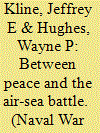

|
|
|
|
|
| Publication |
2012.
|
| Summary/Abstract |
Land-sea wars" have significant maritime dimensions, with command of the sea posited by this study as mattering more than either [land combat] skill or strength. . . . [C]ommand of the sea is a preeminent form of power that determines the outcome of land-sea conflicts.
JOHN ARQUILLA
In a February 2012 article published in the American Interest, General Norton A. Schwartz, Chief of Staffof the U.S. Air Force, and Admiral Jonathan W. Greenert, Chief of Naval Operations, provide solid justification for more closely integrating Air Force and Navy capabilities into an Air-Sea Battle strategy.1 We applaud the Air-Sea Battle component as the most effective means of preparing for the most challenging conflict-full-scale conventional war
|
|
|
|
|
|
|
|
|
|
|
|
|
|
|
|
| 2 |
ID:
105889
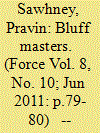

|
|
|
| 3 |
ID:
129938
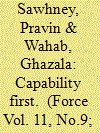

|
|
|
| 4 |
ID:
126124
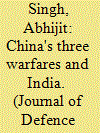

|
|
|
|
|
| Publication |
2013.
|
| Summary/Abstract |
For the past decade, China is known to have actively used 'three warfares' (3Ws) strategy-media, psychological and legal warfare-to weaken its adversaries in regions constituting what it perceives to be its 'core interests'. While a wide range of tools have been deployed, the attacks have remained mostly confined to Taiwan and South-East Asian states involved in the territorial disputes in the South China Sea. But with Beijing's influence in South Asia and the Indian Ocean Region (IOR) growing, there is evidence emerging of the 3Ws strategy being put to use against India. The evolving Chinese 3Ws strategy goes beyond mere propaganda wars and misinformation campaigns. Expanding conventional war dynamics into the political domain, the 3Ws appear aimed at undermining India's organizational foundations and target military morale. More disquietingly, the strategy appears designed to subdue India without even needing to fight.
|
|
|
|
|
|
|
|
|
|
|
|
|
|
|
|
| 5 |
ID:
029125
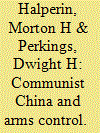

|
|
|
|
|
| Publication |
New York, Frederick A. Praeger, 1965.
|
| Description |
xi, 191p.
|
| Series |
Praeger special studies in international politics and public affairs
|
|
|
|
|
|
|
|
|
|
|
|
Copies: C:1/I:0,R:0,Q:0
Circulation
| Accession# | Call# | Current Location | Status | Policy | Location |
| 000680 | 327.174/HAL 000680 | Main | On Shelf | General | |
|
|
|
|
| 6 |
ID:
130562
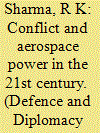

|
|
|
| 7 |
ID:
017676
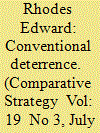

|
|
|
|
|
| Publication |
July-Sept 2000.
|
| Description |
221-254
|
|
|
|
|
|
|
|
|
|
|
|
|
|
|
|
| 8 |
ID:
088518
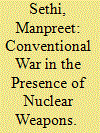

|
|
|
|
|
| Publication |
2009.
|
| Summary/Abstract |
Nuclear weapons cannot obviate wars, but can change its complexion and influence the manner of its conduct. In order to keep nuclear weapons from entering into real warfare, it is important to intelligently judge an adversary's nuclear thresholds and to calibrate one's own conventional strikes. For India, the exploration of this space is particularly important in order to deny Pakistan a free hand to indulge in sub-conventional conflict even as it holds the threat of an all-out nuclear war against an Indian conventional response. This article examines the Indian experience in this regard on the basis of Kargil, 1999. It concludes that limited war - with precise, clearly articulated objectives, calibrated use of military force, and astute use of politico-diplomatic space - offers scope for conduct of conventional war in the presence of nuclear weapons.
|
|
|
|
|
|
|
|
|
|
|
|
|
|
|
|
| 9 |
ID:
118037
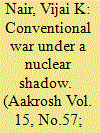

|
|
|
| 10 |
ID:
150751
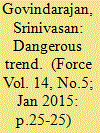

|
|
|
| 11 |
ID:
138679
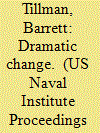

|
|
|
| 12 |
ID:
125375
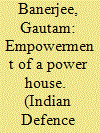

|
|
|
|
|
| Publication |
2013.
|
| Summary/Abstract |
By age-old convention, most wars have various forms of tactical operations undertaken under one overall plan - set-piece, irregular and Special Operations, for example. Indeed, the so called 'conventional war' has always had unconventional tactical recourses built into it. The infantry battalion has been in lead role in such irregular or unconventional operations, its flexibility of structure, weaponry and training allowing it to be moved by any mode of transport and fielded in any of the kind of aforesaid operations - all with equal proficiency and without much ado. The final test may, therefore, be to evaluate the significant flexibility which the infantry battalion has traditionally possessed.
"Do not wait to strike until the iron is hot but make it hot by striking." -William Sprague
|
|
|
|
|
|
|
|
|
|
|
|
|
|
|
|
| 13 |
ID:
054692
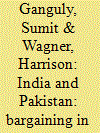

|
|
|
| 14 |
ID:
110673
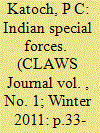

|
|
|
| 15 |
ID:
112823
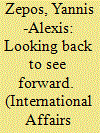

|
|
|
|
|
| Publication |
2012.
|
| Summary/Abstract |
ONE ASPECT OF INTERNATIONAL POLITICS that seems fraught with dialectical tensions at every turn is the effort to give form and substance to the apparent belief of NATO member states that in the face of issues of a global nature the Alliance has a distinctly functional nature in a dense transatlantic institutional environment. To the extent that in the beginning of the 21st century the likelihood of conventional war between major powers is lower than at any time in modern history, NATO's existential basis was severely challenged.
|
|
|
|
|
|
|
|
|
|
|
|
|
|
|
|
| 16 |
ID:
137243
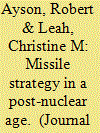

|
|
|
|
|
| Summary/Abstract |
While the arrival of nuclear weapons coincided roughly with the development of short, medium, intermediate, and eventually intercontinental missiles, the contribution of missile technology to the deterrence equation is often lost. If nuclear weapons were eliminated, even new generation missiles with conventional payloads could struggle to render effective deterrence. But some of the physical and psychological effects commonly ascribed to nuclear weapons could still be in play. And in a world without nuclear weapons, thinking about the use and control of force from the nuclear age would also deserve renewed attention.
|
|
|
|
|
|
|
|
|
|
|
|
|
|
|
|
| 17 |
ID:
118639
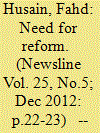

|
|
|
| 18 |
ID:
083906
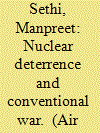

|
|
|
| 19 |
ID:
112227
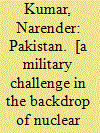

|
|
|
|
|
| Publication |
New Delhi, KW Publishers Pvt Ltd, 2011.
|
| Description |
30p.
|
| Series |
Manekshaw Paper No.33
|
|
|
|
|
|
|
|
|
|
|
|
Copies: C:1/I:0,R:0,Q:0
Circulation
| Accession# | Call# | Current Location | Status | Policy | Location |
| 056418 | 355.021709549/KUM 056418 | Main | On Shelf | General | |
|
|
|
|
| 20 |
ID:
089742
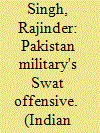

|
|
|
|
|
| Publication |
2009.
|
| Summary/Abstract |
Most people and even some military minds do not appreciate the difference between fighting a conventional war and an unconventional war. The former is against a known enemy with well-defined principles of engagement, but the latter involves an unknown enemy who has the initiative.
|
|
|
|
|
|
|
|
|
|
|
|
|
|
|
|